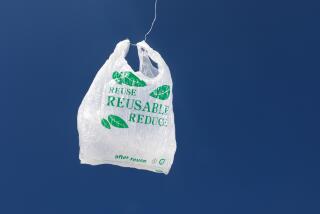Bisphenol A and its potential health risks
- Share via
Concerns about the chemical bisphenol A and its potential health risks have led many consumers to be more careful about the containers they use to carry drinking water and feed their babies. The market has responded with water bottles labeled “BPA-free.”
And then, in late July, the Environmental Working Group, an advocacy organization, reported that high amounts of BPA are present in everyday cash register receipts, as much as 3% of the total weight of the receipt.
Certainly, there would be real concerns if the bisphenol A on receipts readily sloughs off onto the fingers of cashiers and buyers, penetrates several layers of skin and enters the bloodstream at potentially toxic levels, says Kristina Thayer, a scientist at the National Toxicology Program, an interagency group charged with evaluating toxic chemicals. However, she added, no scientific study has even looked for such a pathway.
“It’s a very fair question to ask whether we’ve got a good grasp on all the potential sources of exposure to BPA,” Thayer says. “It’s certainly worthy of more investigation.” Federal agencies are funding such work.
Here’s a closer look at what we know about the likelihood that BPA would enter our bodies without actually swallowing it. Some background: Bisphenol A can mimic actions of estrogen, a reproductive hormone. Most health risk studies have been done in animals and have found breast- and prostate-like cancers and altered growth of these and other reproductive organs during development. The tricky part is figuring out whether the doses tested in rodents are relevant to the types of exposures that people get.
In addition to plastic bottles and food can linings, bisphenol A is found in the chemical coating of some thermal papers — the type used in cash registers that turn color when exposed to heat.
There’s no question that bisphenol A is getting into our bodies. Biomonitoring studies by the U.S. Centers for Disease Control and Prevention have consistently found the chemical in the vast majority of Americans tested. (The U.S. Environmental Protection Agency says a daily safe limit is 50 micrograms per kilogram, or about 3.5 milligrams in a 150-pound person.)
A study published in March in the Journal of Exposure Science and Environmental Epidemiology found that the typical American is well under the EPA limit by a factor of nearly 1,500 (0.034 micrograms per kilogram per day). The finding was based on CDC data: 2005 and 2006 urine samples from 2,548 individuals.
But in 2007, a panel of 38 experts convened to assess BPA’s health risks for the National Institute of Environmental Health Sciences said that the EPA limit, which was based on animal research that tested high doses of the chemical, was outdated. Newer animal research has found that much lower doses — in the range of what people are exposed to — can cause harm to breast, prostate and brain tissues, they noted.
Though the presumption had been that people were being exposed to BPA by eating and drinking food kept in BPA-containing vessels, the idea that BPA from other sources also might contribute had been floating around the research community. Billions of pounds of the chemical are produced every year, and it is used in a wide variety of products. “There is so much and there are so many products that we don’t have any idea where we’re getting our exposures from,” says Scott Belcher, a pharmacologist at the University of Cincinnati who served on the 38-member panel.
A 2009 study in Environmental Health Perspectives found that urinary BPA levels (from CDC biomonitoring studies done in 2003-2004) did not change much, regardless of when participants last ate or drank. This was odd, because BPA is thought to be metabolized quite quickly in the body. The authors concluded that either the chemical is held in the body somehow — accumulating in fat, for instance — or that significant non-food exposure is occurring.
A college class project at the University of Massachusetts Boston in the early 2000s run by then-professor John Warner tested how much was in cash register receipts.”It’s unequivocal. It’s there, and it’s in large amounts,” says Warner, now president and founder of the Warner-Babcock Institute for Green Chemistry in Wilmington, Mass., a company that develops environmentally friendly technologies.
Warner repeated the study and published it in Green Chemistry Letters and Reviews on July 28. Ten receipts collected from 10 stores in the Boston suburbs were tested; eight had measurable BPA, ranging from 3 to 19 milligrams.
The Environmental Working Group tested 36 receipts and found 16 tested positive for BPA; the highest amount was 29 milligrams.
Still, in terms of health risks, Warner adds, “The jury is still out.”
A study by a Swiss group looked at the transfer of BPA from thermal paper to human fingertips. The scientists found a little more than 1 microgram of BPA, on average, on subjects’ fingers after they firmly held the paper for 30 seconds. More — up to 23 micrograms — was found if the fingers were wet. The paper was published online July 11 in the journal Analytical and Bioanalytical Chemistry.
Another study, published in the Journal of Toxicology and Environmental Health, examined how much BPA can penetrate pig skin and found much of it remained on the surface layers. This might suggest that little would enter the bloodstream.
But contaminated fingers also could rub an eye or enter a mouth, aiding the chemical’s entry there. “I try to avoid it as much as I can,” Belcher says. “And I’m pretty pragmatic about things.”
Though the risks are unclear, the solution is simple, Warner says. Only some cash receipts have BPA in them — in other words, he says, “there is already a competitive technology.”
health@latimes.com






